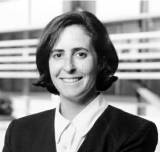Awardee Interviews | Biography: Stacey F. Bent
Stacey F. Bent

Stacey F. Bent received her B.S. degree in Chemical Engineering from the University of California, Berkeley, in 1987. She attended graduate school as a National Science Foundation Predoctoral Fellow at Stanford University, earning her Ph.D. in Chemistry under Richard Zare in 1992. Her thesis research used quantum state-resolved detection of molecular hydrogen to probe the dynamics of recombinative desorption of hydrogen from silicon surfaces. The results from these studies have played a key role in the current understanding of hydrogen interactions with silicon surfaces. During graduate school, Bent enjoyed several research opportunities at AT&T Bell Laboratories under their Graduate Research Program for Women, where she worked with John Tully and Mark Cardillo on gas-surface scattering, and with Alex Harris on sum-frequency generation measurements of surface vibrational energy relaxation. In 1992, Bent joined AT&T Bell Laboratories at Murray Hill, New Jersey as a postdoctoral fellow working with William Wilson on ultrafast laser spectroscopy of electroluminescent materials engineered using molecular self-assembly.
In 1994, Bent joined the faculty as an Assistant Professor in the Department of Chemistry at New York University. In 1998, she moved to Stanford University, where she is currently an Assistant Professor of Chemical Engineering. At Stanford, Bent also holds courtesy faculty appointments in the Department of Chemistry and the Department of Electrical Engineering. Her research activities have focused on electronic materials processing and semiconductor surface chemistry. In 1997, Bent and coworkers showed that a classic reaction in organic chemistry, the Diels-Alder reaction, can be used to functionalize a silicon surface with an organic layer in vacuum. This work introduced what may become an important method for controlled synthesis of organic/semiconductor interfaces for generation of novel electronic devices, and helped provide a new conceptual picture of how the silicon surface reacts. Bent and coworkers later demonstrated the generality of the surface Diels-Alder product at germanium and diamond surfaces.
In addition to their work investigating organics on semiconductors, Bent's group has been at the forefront in utilizing in situ molecular-level spectroscopic methods to follow semiconductor processing, including chemical vapor deposition and etching. They have applied these techniques to obtain detailed kinetic parameters for fundamental reactions in amorphous semiconductor growth and processing. Current research is exploring new approaches for surface functionalization, the development of laser-based detection of free radicals in chemical vapor deposition, and studies of amorphous and nanocrystalline semiconductors.
Bent has been the recipient of a National Science Foundation CAREER Award, the Beckman Young Investigator Award, a Camille Dreyfus Teacher-Scholar Award, a Cottrell Scholar Award from the Research Corporation, and a Terman Faculty Fellowship from Stanford University. Bent is a member of the executive committee of the AVS Surface Science Division and is Program Chair-Elect of SSD for the 2002 national meeting. She is also a member of the Program Committee for the 2001 International Vacuum Congress (lVC-I5) Symposium.